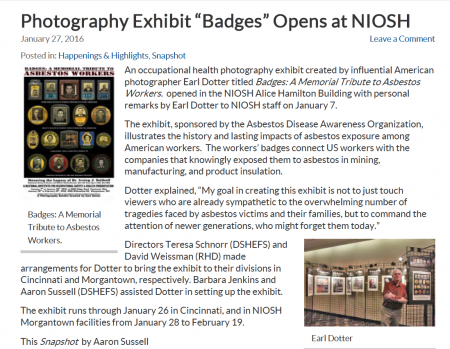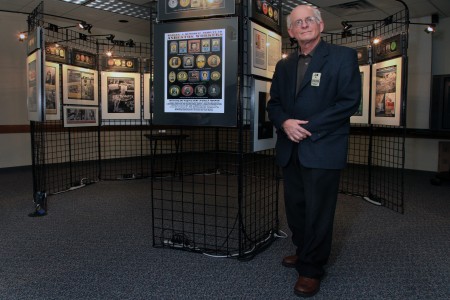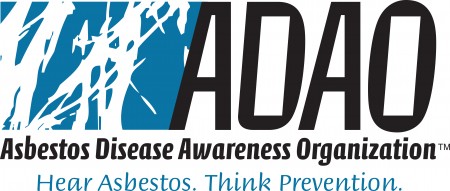Posted on January 30, 2016
Earl Dotter’s BADGES: A Memorial Tribute to Asbestos Workers exhibit began its tour of National Institutes for Occupational Health and Safety (NIOSH) facilities, opening in Cincinnati on January 7th at its Hamilton Building. Because of severe weather in West Virginia, the second showing at NIOSH’s Morgantown, WV Laboratory Facility has been postponed by one week and is set to open there on February 4th through the 25th.
The exhibit’s Opening Reception Presentation in NOISH’S Hamilton Building was quite well attended with about 100 NIOSH staff from both the Taft and Hamilton Buildings first viewing the expanded exhibit, Then Dotter spoke to the gathering in a large meeting room nearby with a lively Q&A session afterwards.
The photojournalist began with a short history of how his employee photo badge collecting of badges from hazardous industries lead to this exhibit idea. Many of the employees shown on the company badges in Dotter’s collection were impacted by asbestos exposure at their job sites. With exhibit development assistance from the Asbestos Disease Organization and Asbestos expert, Barry Castleman, Dotter created a visual history up to the present Third Wave of Environmental asbestos exposure with the photo employee badges personalizing that tragic story in a poignant way.
“It has been my goal for the BADGES exhibit to inform the present generation of what may well be the largest public and industrial health tragedy in American history, with a World Wide toll also still unfolding,” Dotter recounted to the group.

Earl Dotter also spoke about successfully reaching out to the one of the grandchildren of asbestos victim Clarence Borel, who died before receiving the first asbestos disease compensation award for the fatal disease he contracted on the job. His lawyer presented to the trial judge the medical research published in 1965 by Dr. Irving Selikoff that incontrovertibly linked exposure to asbestos to the disease, after a latency period of 20 to 30 years for the disease to manifest itself after first exposure.
This knowledge lead the Federal Judge in the Borel trial to eliminate the Statute of Limitations that had caused previous plaintiff cases to be dismissed. Borel’s attorney also presented the discovery findings of investigative reporter, Paul Brodeur documenting that Johns Manville knew of the occupational exposure hazards to asbestos as early as 1929. Brodeur showed through J-M documents that the company had enacted a cover up, never informing their employees of the hazards of asbestos. Once the trial judge had this information, he deemed the J-M company criminally liable for not informing their employees of the potentially lethal hazards from exposure to asbestos.
The Borel award of $79,000 came to his widow because Clarence had died several months before the judge ruled in his favor, and his lawyer had died several years earlier. Panels about Clarence Borel’s significance and other additions to the exhibit are set to be inaugurated with the fully developed exhibit at the 12th Annual ADAO Asbestos Awareness and Prevention Conference, April 8th-10th. The BADGES exhibit will also be shown at the American Industrial Hygiene Association Annual Conference and Exposition, May 21-26 in Baltimore and at the University of Texas in Tyler, June 15-18 this year.
ADAO is proud to be the sponsor of Earl Dotter’s impressive BADGES: A Memorial Tribute to Asbestos Workers exhibit.
Linda Reinstein

